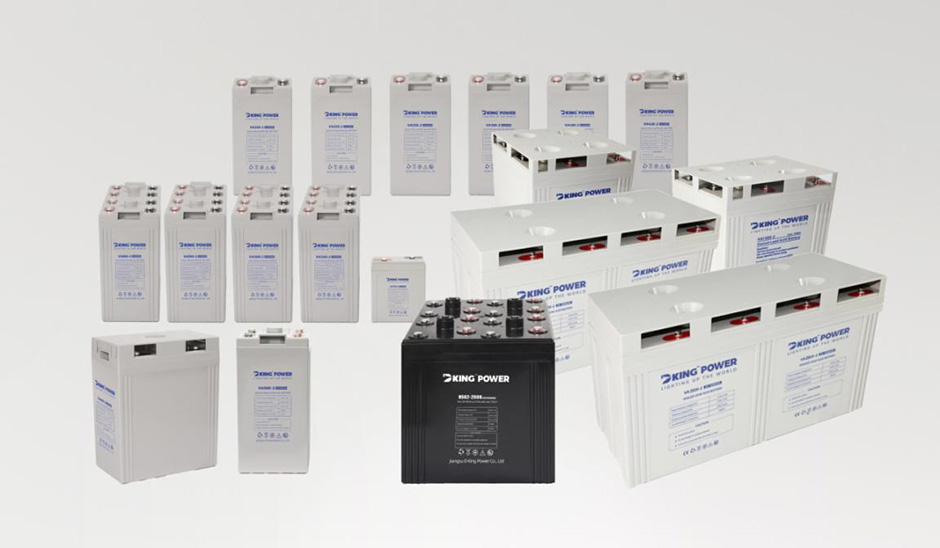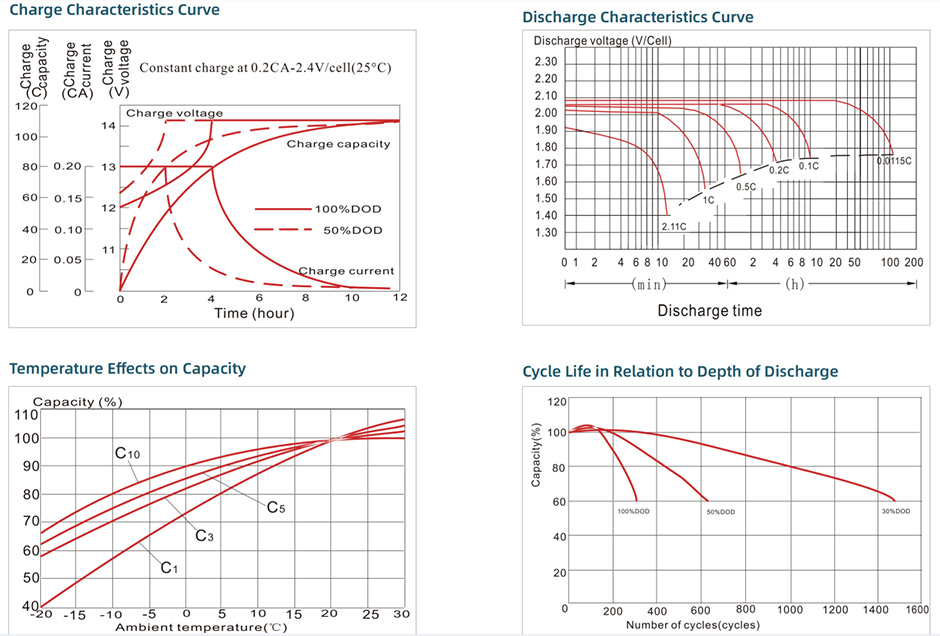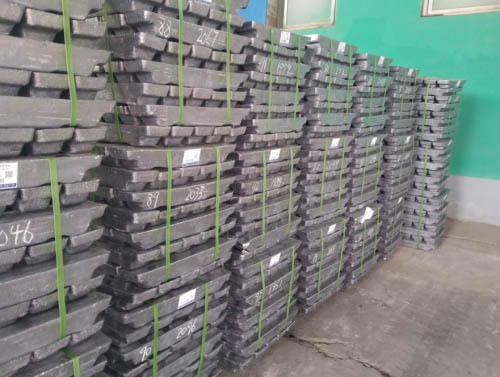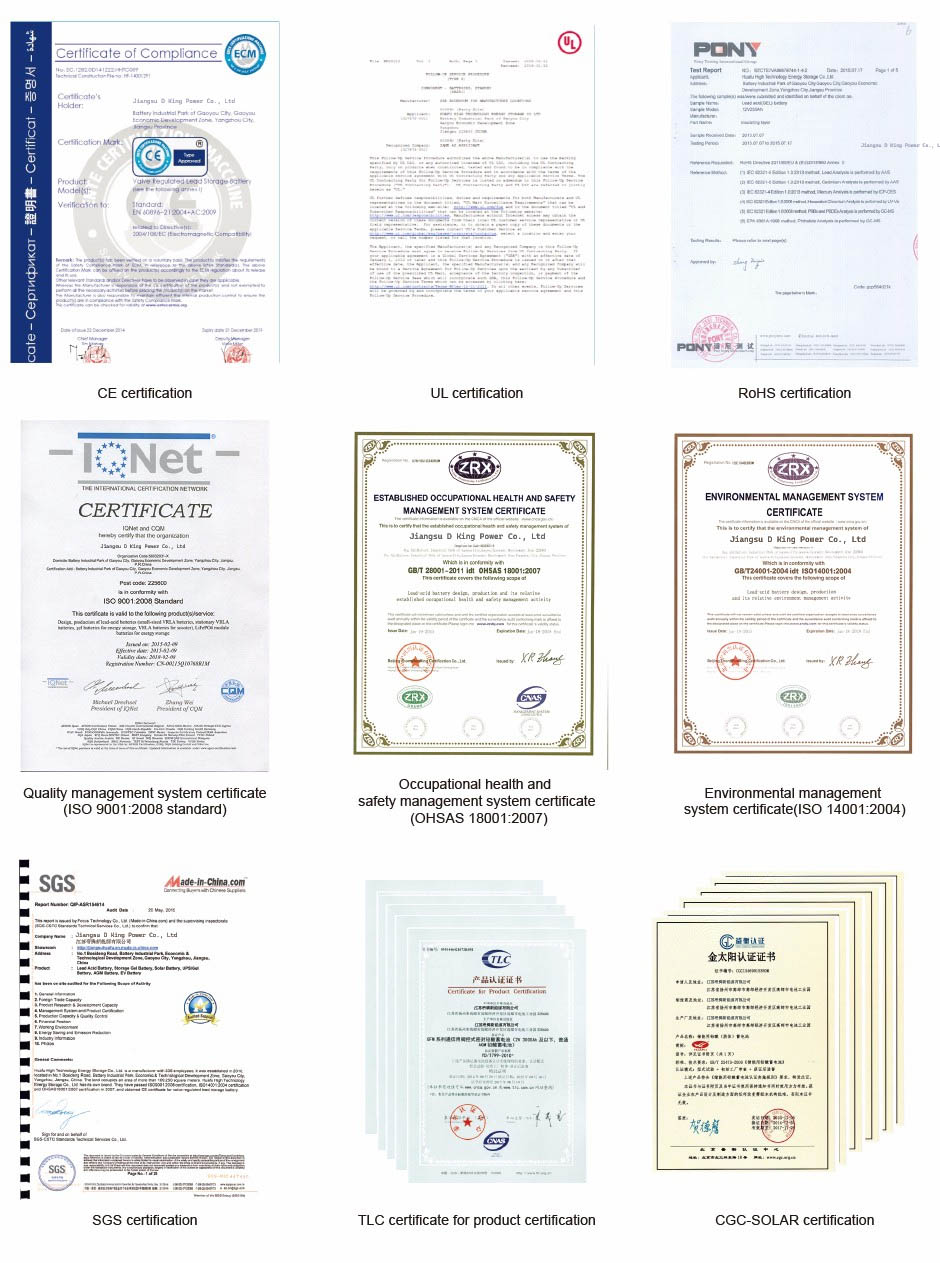DKGB2-200-2V200AH SEALED GEL LEAD ACID BATTERY
Technical Features
1. Charging efficiency: The usage of imported low resistance raw materials and advanced process help make theinternal resistance smaller and the acceptance ability of small current charging stronger.
2. High and low temperature tolerance: Wide temperature range (lead-acid:-25-50 C ,and gel:-35-60 C), suitablefor indoor and outdoor use in varies environments.
3. Long cycle-life: The design life of lead acid and gel series reach to more than 15 and 18 years respectively, forthe arid is corrosion- resistant. and electrolvte is without risk of stratification by using multiple rare-earth alloy ofindependent intellectual property rights, nanoscale fumed silica imported from Germany as base materials, andelectrolyte of nanometer colloid all by independent research and development.
4. Environment-friendly: Cadmium (Cd), which is poisonous and not easy to recycle, does not exist. Acid leakageof gel electrolvte will not happen. The battery operates in safety and environmental protection.
5. Recovery performance: The adoption of special alloys and lead paste formulations make a low self-dischargerate, good deep discharge tolerance, and strong recover capability.

Parameter
|
Model |
Voltage |
Capacity |
Weight |
Size |
|
DKGB2-100 |
2v |
100Ah |
5.3kg |
171*71*205*205mm |
|
DKGB2-200 |
2v |
200Ah |
12.7kg |
171*110*325*364mm |
|
DKGB2-220 |
2v |
220Ah |
13.6kg |
171*110*325*364mm |
|
DKGB2-250 |
2v |
250Ah |
16.6kg |
170*150*355*366mm |
|
DKGB2-300 |
2v |
300Ah |
18.1kg |
170*150*355*366mm |
|
DKGB2-400 |
2v |
400Ah |
25.8kg |
210*171*353*363mm |
|
DKGB2-420 |
2v |
420Ah |
26.5kg |
210*171*353*363mm |
|
DKGB2-450 |
2v |
450Ah |
27.9kg |
241*172*354*365mm |
|
DKGB2-500 |
2v |
500Ah |
29.8kg |
241*172*354*365mm |
|
DKGB2-600 |
2v |
600Ah |
36.2kg |
301*175*355*365mm |
|
DKGB2-800 |
2v |
800Ah |
50.8kg |
410*175*354*365mm |
|
DKGB2-900 |
2v |
900AH |
55.6kg |
474*175*351*365mm |
|
DKGB2-1000 |
2v |
1000Ah |
59.4kg |
474*175*351*365mm |
|
DKGB2-1200 |
2v |
1200Ah |
59.5kg |
474*175*351*365mm |
|
DKGB2-1500 |
2v |
1500Ah |
96.8kg |
400*350*348*382mm |
|
DKGB2-1600 |
2v |
1600Ah |
101.6kg |
400*350*348*382mm |
|
DKGB2-2000 |
2v |
2000Ah |
120.8kg |
490*350*345*382mm |
|
DKGB2-2500 |
2v |
2500Ah |
147kg |
710*350*345*382mm |
|
DKGB2-3000 |
2v |
3000Ah |
185kg |
710*350*345*382mm |

production process

Lead ingot raw materials
Polar plate process
Electrode welding
Assemble process
Sealing process
Filling process
Charging process
Storage and shipping
Certifications

Advantages and disadvantages of lithium battery, lead acid battery and gel battery
Lithium battery
The working principle of lithium battery is shown in the figure below. During discharge, the anode loses electrons, and lithium ions migrate from the electrolyte to the cathode; On the contrary, the lithium ion migrates to the anode during the charging process.
Lithium battery has higher energy weight ratio and energy volume ratio; Long service life. Under normal working conditions, the number of battery charging/discharging cycles is far greater than 500; Lithium battery is usually charged with current of 0.5~1 times of capacity, which can shorten the charging time; The battery components do not contain heavy metal elements, which will not pollute the environment; It can be used in parallel at will, and the capacity is easy to allocate. However, its battery cost is high, which is mainly reflected in the high price of the cathode material LiCoO2 (less Co resources), and the difficulty in purifying the electrolyte system; The internal resistance of the battery is larger than that of other batteries due to organic electrolyte system and other reasons.
Lead acid battery
The principle of lead-acid battery is as follows. When the battery is connected to the load and discharged, dilute sulfuric acid will react with the active substances on the cathode and anode to form a new compound lead sulfate. The sulfuric acid component is released from the electrolyte through discharge. The longer the discharge is, the thinner the concentration is; Therefore, as long as the concentration of sulfuric acid in the electrolyte is measured, the residual electricity can be measured. As the anode plate is charged, the lead sulfate generated on the cathode plate will be decomposed and reduced to sulfuric acid, lead and lead oxide. Therefore, the concentration of sulfuric acid gradually increases. When the lead sulfate at both poles is reduced to the original substance, it is equal to the end of charging and waiting for the next discharge process.
Lead acid battery has been industrialized for the longest time, so it has the most mature technology, stability and applicability. The battery uses dilute sulfuric acid as electrolyte, which is non combustible and safe; Wide range of operating temperature and current, good storage performance. However, its energy density is low, its cycle life is short, and lead pollution exists.
Gel Battery
Colloidal battery is sealed by the principle of cathode absorption. When the battery is charged, oxygen will be released from the positive electrode and hydrogen will be released from the negative electrode. Oxygen evolution from the positive electrode starts when the positive electrode charge reaches 70%. The oxygen precipitated reaches the cathode and reacts with the cathode as follows to achieve the purpose of cathode absorption.
2Pb+O2=2PbO
2PbO+2H2SO4: 2PbS04+2H20
The hydrogen evolution of the negative electrode starts when the charge reaches 90%. In addition, the reduction of oxygen on the negative electrode and the improvement of the hydrogen overpotential of the negative electrode itself prevent a large amount of hydrogen evolution reaction.
For AGM sealed lead acid batteries, although most of the electrolyte of the battery is kept in the AGM membrane, 10% of the membrane pores must not enter the electrolyte. The oxygen generated by the positive electrode reaches the negative electrode through these pores and is absorbed by the negative electrode.
The colloid electrolyte in the colloid battery can form a solid protective layer around the electrode plate, which will not lead to the decrease of capacity and long service life; It is safe to use and conducive to environmental protection, and belongs to the real sense of green power supply; Small self discharge, good deep discharge performance, strong charge acceptance, small upper and lower potential difference, and large capacitance. But its production technology is difficult and the cost is high.














